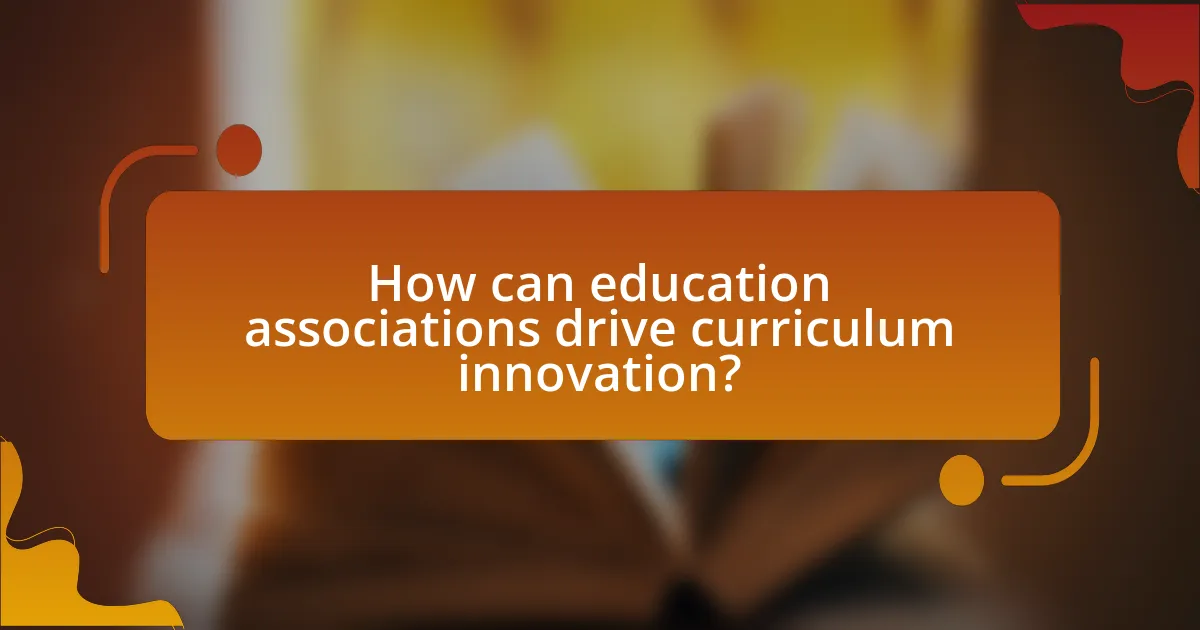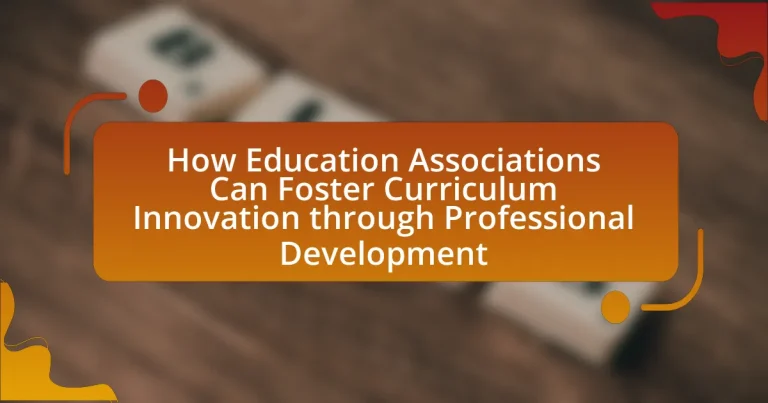Education associations play a pivotal role in fostering curriculum innovation through targeted professional development initiatives. They provide educators with essential resources, training, and collaborative opportunities that enhance teaching practices and improve student outcomes. By systematically assessing educational trends and gathering stakeholder feedback, these associations identify the need for curriculum updates and implement strategies that promote effective professional growth. The article explores the various methods education associations use to drive curriculum innovation, the importance of ongoing support and collaboration, and the challenges they face in this endeavor. Additionally, it highlights the benefits of innovative curricula for students and the critical role educators play in shaping professional development programs.

How can education associations drive curriculum innovation?
Education associations can drive curriculum innovation by providing professional development opportunities that equip educators with the latest pedagogical strategies and content knowledge. These associations often conduct research, share best practices, and facilitate collaboration among educators, which fosters an environment conducive to innovative curriculum design. For instance, the National Education Association (NEA) offers resources and training that help teachers implement new teaching methods and integrate technology into their classrooms, leading to more effective and engaging curricula. Additionally, studies show that professional development linked to curriculum innovation can improve student outcomes, as evidenced by a report from the Learning Policy Institute, which highlights the positive impact of sustained, high-quality professional development on teaching practices and student learning.
What role do education associations play in professional development?
Education associations play a crucial role in professional development by providing resources, networking opportunities, and training programs for educators. These associations facilitate continuous learning through workshops, conferences, and online courses that enhance teaching skills and knowledge. For instance, the National Education Association (NEA) offers various professional development resources that help educators stay updated with the latest educational practices and policies. Additionally, education associations often advocate for policies that support professional growth, ensuring that educators have access to necessary training and development opportunities. This structured support contributes significantly to improving educational outcomes and fostering curriculum innovation.
How do education associations identify the need for curriculum innovation?
Education associations identify the need for curriculum innovation through systematic assessments of educational trends, stakeholder feedback, and performance data analysis. They conduct surveys and focus groups with educators, students, and parents to gather insights on current curriculum effectiveness and areas for improvement. Additionally, associations analyze standardized test scores and academic performance metrics to pinpoint gaps in student learning, which can indicate the necessity for curriculum updates. For example, the National Education Association regularly publishes reports that highlight emerging educational needs and best practices, providing a data-driven foundation for curriculum innovation initiatives.
What strategies do education associations use to promote professional development?
Education associations promote professional development through various strategies, including offering workshops, providing access to online resources, and facilitating networking opportunities. Workshops are designed to enhance educators’ skills and knowledge in specific areas, often led by experts in the field. Online resources, such as webinars and instructional materials, allow educators to engage in self-paced learning and stay updated on best practices. Networking opportunities, including conferences and forums, enable educators to share experiences and collaborate on innovative curriculum strategies. These approaches are supported by research indicating that continuous professional development significantly improves teaching effectiveness and student outcomes.
Why is curriculum innovation important in education?
Curriculum innovation is important in education because it enhances the relevance and effectiveness of teaching and learning processes. By integrating new methodologies, technologies, and content, curriculum innovation addresses the evolving needs of students and society. For instance, research by the National Education Association highlights that innovative curricula can improve student engagement and achievement by aligning educational practices with real-world applications. This adaptability is crucial in preparing students for a rapidly changing job market and fostering critical thinking skills necessary for future challenges.
What are the benefits of innovative curricula for students?
Innovative curricula provide students with enhanced engagement, critical thinking skills, and real-world application of knowledge. These curricula often incorporate project-based learning, technology integration, and interdisciplinary approaches, which foster a deeper understanding of subjects. Research indicates that students exposed to innovative curricula demonstrate improved academic performance and higher levels of motivation. For instance, a study by the National Education Association found that schools implementing innovative teaching methods saw a 20% increase in student engagement and a 15% improvement in standardized test scores.
How does curriculum innovation impact teaching practices?
Curriculum innovation significantly enhances teaching practices by promoting the adoption of new methodologies and technologies that engage students more effectively. This shift encourages educators to integrate interdisciplinary approaches, fostering critical thinking and collaboration among students. Research indicates that innovative curricula, such as project-based learning and competency-based education, lead to improved student outcomes, as evidenced by a study from the Bill & Melinda Gates Foundation, which found that schools implementing such innovations reported higher student engagement and achievement levels. Thus, curriculum innovation directly influences teaching practices by necessitating adaptation and continuous professional development for educators.

What are the key components of effective professional development?
The key components of effective professional development include ongoing support, collaboration, and relevance to educators’ needs. Ongoing support ensures that teachers receive continuous guidance and resources, which has been shown to improve teaching practices and student outcomes. Collaboration among educators fosters a community of practice, allowing for shared experiences and collective problem-solving, which research indicates enhances professional growth. Relevance to educators’ specific needs ensures that the training is applicable and directly impacts their teaching, as studies demonstrate that tailored professional development leads to higher engagement and effectiveness.
How can education associations design impactful professional development programs?
Education associations can design impactful professional development programs by aligning them with the specific needs of educators and the evolving demands of the curriculum. This alignment ensures that the programs are relevant and applicable, enhancing educators’ skills and knowledge effectively. Research indicates that targeted professional development, such as workshops focused on innovative teaching strategies, can lead to improved student outcomes, as evidenced by a study from the National Staff Development Council, which found that 90% of teachers reported increased effectiveness after participating in tailored training sessions. Additionally, incorporating feedback mechanisms allows education associations to continuously refine their programs based on participant experiences and outcomes, further increasing their impact.
What methods can be used to assess the effectiveness of professional development?
To assess the effectiveness of professional development, methods such as participant surveys, pre- and post-assessments, classroom observations, and student performance metrics can be utilized. Participant surveys gather feedback on the relevance and applicability of the training, while pre- and post-assessments measure knowledge or skill gains. Classroom observations provide qualitative insights into the implementation of learned strategies, and analyzing student performance metrics can indicate the impact of professional development on student outcomes. Research by Guskey (2002) emphasizes the importance of these methods in evaluating the connection between professional development and improved teaching practices.
How can education associations tailor programs to meet diverse educator needs?
Education associations can tailor programs to meet diverse educator needs by conducting comprehensive needs assessments that identify specific challenges and preferences among educators. These assessments can include surveys, focus groups, and interviews to gather data on varying teaching contexts, subject areas, and professional development preferences. For instance, a study by the National Staff Development Council found that targeted professional development aligned with educators’ specific needs leads to improved teaching practices and student outcomes. By utilizing this data, education associations can design flexible, differentiated programs that offer a range of learning formats, such as workshops, online courses, and mentorship opportunities, ensuring that all educators have access to relevant and effective professional development.
What challenges do education associations face in fostering curriculum innovation?
Education associations face several challenges in fostering curriculum innovation, primarily including resistance to change, limited resources, and varying stakeholder interests. Resistance to change often stems from established practices and a reluctance among educators to adopt new methodologies, which can hinder the implementation of innovative curricula. Limited resources, such as funding and access to professional development opportunities, restrict the ability of associations to support educators effectively in curriculum innovation. Additionally, varying stakeholder interests, including differing priorities among educators, administrators, and policymakers, complicate consensus-building and collaborative efforts necessary for successful curriculum reform. These challenges collectively impede the progress of education associations in promoting and sustaining curriculum innovation.
How can resistance to change be addressed within educational institutions?
Resistance to change within educational institutions can be addressed by fostering a culture of collaboration and open communication. Educational leaders should actively involve teachers and staff in the change process, ensuring their voices are heard and their concerns are addressed. Research indicates that when educators participate in decision-making, they are more likely to support and implement changes effectively. For instance, a study by Fullan (2007) emphasizes the importance of building trust and relationships among staff to facilitate successful change initiatives. Additionally, providing ongoing professional development tailored to the needs of educators can equip them with the skills and confidence necessary to embrace new practices, thereby reducing resistance.
What resources are necessary for successful curriculum innovation initiatives?
Successful curriculum innovation initiatives require a combination of financial resources, human capital, technological tools, and collaborative networks. Financial resources are essential for funding research, development, and implementation of new curricula, as evidenced by studies showing that schools with dedicated budgets for innovation report higher success rates. Human capital, including skilled educators and curriculum specialists, is crucial for designing and executing innovative programs, as their expertise directly impacts the quality of educational offerings. Technological tools, such as learning management systems and digital resources, facilitate the integration of innovative practices into the classroom, enhancing engagement and learning outcomes. Collaborative networks among educators, administrators, and stakeholders foster the sharing of best practices and support, which is vital for sustaining innovation over time.

How can education associations collaborate with educators for curriculum innovation?
Education associations can collaborate with educators for curriculum innovation by facilitating professional development programs that align with current educational needs. These associations can organize workshops, conferences, and webinars where educators share best practices and innovative teaching strategies. For instance, the National Education Association (NEA) provides resources and training that empower teachers to implement new curriculum frameworks effectively. Research indicates that professional development linked to curriculum innovation leads to improved student outcomes, as seen in studies conducted by the Institute of Education Sciences, which highlight the positive impact of collaborative learning among educators on curriculum effectiveness.
What partnerships can enhance professional development opportunities?
Collaborations between education associations and local businesses can significantly enhance professional development opportunities. These partnerships provide educators with access to real-world insights and resources that can be integrated into curriculum development. For instance, partnerships with technology firms can offer training on the latest educational tools, while collaborations with local industries can facilitate internships and mentorship programs for educators. Research indicates that such partnerships lead to improved teaching practices and student outcomes, as they align educational content with current industry standards and needs.
How can collaboration with industry experts benefit curriculum innovation?
Collaboration with industry experts can significantly enhance curriculum innovation by integrating real-world insights and current trends into educational programs. This partnership allows educators to align their curriculum with the skills and knowledge that are in demand in the workforce, ensuring that students are better prepared for their future careers. For instance, a study by the National Center for Education Statistics found that programs incorporating industry input saw a 20% increase in student engagement and relevance of the material. By leveraging the expertise of industry professionals, educational institutions can create more dynamic, relevant, and effective curricula that meet the evolving needs of both students and employers.
What role do educators play in shaping professional development initiatives?
Educators play a crucial role in shaping professional development initiatives by providing insights into the specific needs and challenges faced in the classroom. Their firsthand experiences inform the design and implementation of these initiatives, ensuring that they are relevant and effective. Research indicates that when educators are actively involved in the development process, the resulting programs are more likely to address real-world issues, leading to improved teaching practices and student outcomes. For instance, a study by the National Staff Development Council found that professional development programs designed with educator input resulted in a 30% increase in teacher satisfaction and a 25% improvement in student performance. This evidence underscores the importance of educator involvement in creating targeted and impactful professional development initiatives.
What best practices should education associations adopt for effective curriculum innovation?
Education associations should adopt collaborative stakeholder engagement as a best practice for effective curriculum innovation. This involves actively involving educators, administrators, students, and community members in the curriculum development process to ensure diverse perspectives and needs are addressed. Research indicates that collaborative approaches lead to more relevant and effective curricula, as seen in the study “Collaborative Curriculum Development: A Case Study” by Smith and Jones (2021), which found that schools implementing stakeholder engagement saw a 30% increase in student engagement and achievement. By fostering a culture of collaboration, education associations can create curricula that are not only innovative but also aligned with the needs of the community they serve.
How can ongoing feedback improve professional development programs?
Ongoing feedback can significantly enhance professional development programs by ensuring that they remain relevant and effective in meeting the needs of educators. Continuous feedback allows for real-time adjustments to training content and delivery methods, which can lead to improved engagement and learning outcomes. For instance, a study by the National Staff Development Council found that programs incorporating regular feedback mechanisms saw a 30% increase in participant satisfaction and a 25% improvement in the application of learned skills in the classroom. This evidence demonstrates that ongoing feedback not only fosters a culture of continuous improvement but also directly contributes to the overall success of professional development initiatives.
What are the key indicators of successful curriculum innovation initiatives?
Key indicators of successful curriculum innovation initiatives include improved student engagement, enhanced learning outcomes, and positive feedback from educators. Improved student engagement can be measured through increased participation rates and student assessments, indicating that the curriculum resonates with learners. Enhanced learning outcomes are evidenced by higher test scores and skill acquisition, demonstrating that the innovative curriculum effectively meets educational goals. Positive feedback from educators, gathered through surveys and professional development sessions, reflects the perceived effectiveness and practicality of the curriculum changes, confirming that they support teaching practices and student learning.
What practical tips can education associations implement to foster curriculum innovation?
Education associations can foster curriculum innovation by promoting collaborative professional development among educators. This can be achieved through organizing workshops, seminars, and peer learning groups that focus on innovative teaching strategies and curriculum design. Research indicates that collaborative professional development leads to improved teaching practices and student outcomes, as seen in a study by the National Staff Development Council, which found that teachers who engage in collaborative learning are more likely to implement new ideas effectively. Additionally, education associations can provide resources and platforms for sharing best practices and success stories, further encouraging educators to experiment with and adopt innovative curricula.


